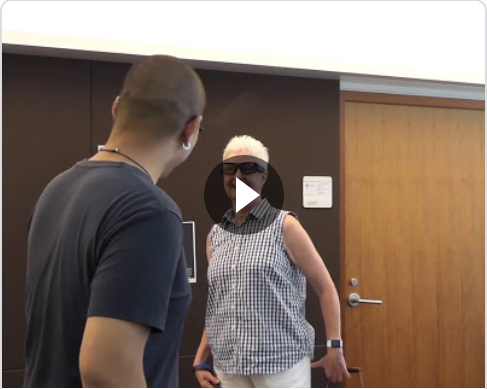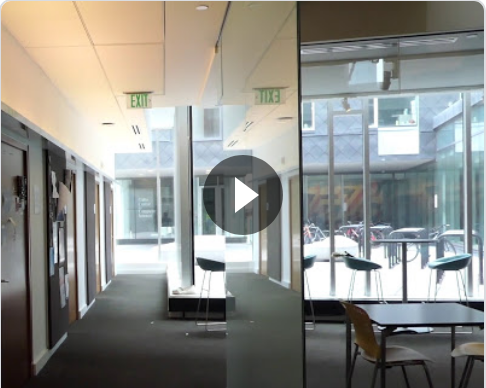Pedestrian Detection with Wearable Cameras for the Blind: A Two-way Perspective
Videos
Glasses
Video1 (V1): A perspective of a sighted passerby
Video2 (V2): A perspective of a blind user
GoPro
Video1 (V1): A perspective of a sighted passerby
Video2 (V2): A perspective of a blind user
Question types
There are four different types of questions used in our user studies:
- 7-scale Agreement/Disagreement (7-scale)
- Strongly disagree
- Moderately disagree
- Slightly disagree
- Neutral
- Slightly agree
- Moderately agree
- Strongly agree
- Yes/No (Y/N)
- Yes
- No
- Open-ended (Open)
- Check all that apply (Check)
Questions for sighted participants
Attitude towards technology
- (7-scale) I feel it is important to be able to find any information whenever I want through technology.
- (7-scale) I feel it is important to be able to access the Internet any time I want.
- (7-scale) I think it is important to keep up with the latest trends in technology.
- (7-scale) I get anxious when I don’t have my cell phone.
- (7-scale) I get anxious when I don’t have the Internet available to me.
- (7-scale) I am dependent on my technology.
- (7-scale) Technology will provide solutions to many of our problems.
- (7-scale) With technology anything is possible.
- (7-scale) I feel that I get more accomplished because of technology.
- (7-scale) New technology makes people waste too much time.
- (7-scale) New technology makes life more complicated.
- (7-scale) New technology makes people more isolated.
Attitude towards wearable technology (asked in pre- and post-study)
- (7-scale) I feel it is important to be able to access information any time I want through wearable technology such as smart glasses.
- (7-scale) Wearable technology such as smart glasses will provide solutions to many of our problems.
- (7-scale) With wearable technology anything is possible.
- (7-scale) Wearable technology such as smart glasses is awkward.
- (7-scale) Wearable technology such as smart glasses makes interactions more complicated.
- (7-scale) Wearable technology such as smart glasses is invasive.
Questions after video1 (V1) that shows the perspective of a pedestrian
- (7-scale) It was easy to notice that the blind passerby was wearing a camera.
- (7-scale) [OkayAssistUse] I think it is OK for people to wear such a device in public spaces if they have visual impairments (e.g., individuals who are blind or have low vision).
- (7-scale) [OkayAnyUse] I think it is OK for people to wear such a device in public spaces independently of whether they have a visual impairment or not.
- (7-scale) [PrivacyConcerns] I think there are many privacy issues with people wearing such a device in public spaces even if they have a visual impairment.
- (7-scale) [UncomfortableAssistUse] I feel uncomfortable to see people wearing such a device in public spaces even if they have a visual impairment.
- (7-scale) [OkayRecording] I am OK with the camera recording me if it is to improve the accuracy of the assistive device allowing blind individuals to have the same access to their passerby as a sighted individual.
- (7-scale) [OkaySingleUse] I am OK if the camera is using a photo or video for one-time detection only and not saving it at all.
- (7-scale) [UncomfortableRecording] I feel uncomfortable if the camera is recording me.
- (7-scale) [UncomfortableSingleUse] I feel uncomfortable even if the camera is using a photo or video for one-time detection only and not saving it at all.
Questions after video2 (V2) that shows the perspective of a blind user
- (Y/N) Have you previously seen or used a head-worn camera similar to the one shown in the video before you participated in our study?
- (7-scale) [Scenario1 (presence, distance)] I am OK with the camera detecting my presence and the distance between the blind user and me.
- (7-scale) [Scenario2 (basic visual features)] I am OK with the camera detecting my basic visual attributes, such as age and gender.
- (7-scale) [Scenario3 (more visual features)] I am OK with the camera detecting more of my visual attributes, such as age, gender, hair color, facial expression, ethnicity, and/or actions (reading a book, looking at a phone).
- (7-scale) [Scenario4 (recognition)] I am OK with the camera recognizing me (i.e., my name) when I know the blind user.
- (7-scale) [Recognition of any people] I am OK with the camera recognizing me (i.e., my name) when I don’t know the blind user.
Passerby perspective on real-world scenarios
- (Check) What What kind of information about yourself would you not like to be detected by the camera and provided to blind users? (Check all that apply)
- Age
- Gender
- Height
- Hair color
- Ethnicity
- Facial expression
- Gaze estimation
- Clothes
- Carrying objects
- Action
- Other - write in
- None of the above
- (Check) What type of camera do you think would be acceptable to be used by people with visual impairments in public area? (Check all that apply)
- Big visible camera
- Small visible camera (e.g., smartphones)
- Less visible camera (e.g., smart glasses)
- Invisible camera (e.g., spy camera)
- Other - write in
- None of the above
Perception of wearable device after V2
- (7-scale) I think it is OK for people to wear such a device in public spaces if they have visual impairments (e.g., individuals who are blind or have low vision).
- (7-scale) I think it is OK for people to wear such a device in public spaces independently of whether they have a visual impairment or not.
- (7-scale) I think there are many privacy issues with people wearing such a device in public spaces even if they have a visual impairment.
- (7-scale) I feel uncomfortable to see people wearing such a device in public spaces even if they have a visual impairment.
- (7-scale) I feel that watching and understanding how the camera is actually used by the blind individual changes my perspective toward this technology.
Questions related to their
- (Y/N) Do you have any personal experience interacting with family members or friends who have visual impairments?
- (Y/N) Do you have any volunteer or work experience where you interacted with people with visual impairments?
- (Y/N) Do you have any personal experience interacting with family members or friends who have any other disabilities?
- (Y/N) Do you have any volunteer or work experience where you interacted with people with other disabilities?
Questions for blind participants
Experience with wearable technology
- (Y/N) Have you ever used or tried any technology that you can wear such as a hat-mounted camera, a neck lanyard for your phone recording while in motion, or any other device worn on the body?
- (Open) If yes, please indicate for each device; for how long you have used it, how often, and for what purpose.
Attitude towards technology
- (7-scale) I feel it is important to be able to find any information whenever I want through technology.
- (7-scale) I feel it is important to be able to access the Internet any time I want.
- (7-scale) I think it is important to keep up with the latest trends in technology.
- (7-scale) I get anxious when I don’t have my cell phone.
- (7-scale) I get anxious when I don’t have the Internet available to me.
- (7-scale) I am dependent on my technology.
- (7-scale) Technology will provide solutions to many of our problems.
- (7-scale) With technology anything is possible.
- (7-scale) I feel that I get more accomplished because of technology.
- (7-scale) New technology makes people waste too much time.
- (7-scale) New technology makes life more complicated.
- (7-scale) New technology makes people more isolated.
Attitude towards wearable technology (asked in pre- and post-study)
- (7-scale) I feel it is important to be able to access information any time I want through wearable technology such as smart glasses.
- (7-scale) Wearable technology such as smart glasses will provide solutions to many of our problems.
- (7-scale) With wearable technology anything is possible.
- (7-scale) Wearable technology such as smart glasses is awkward.
- (7-scale) Wearable technology such as smart glasses makes interactions more complicated.
- (7-scale) Wearable technology such as smart glasses is invasive.
Social interaction
- (7-scale) I like making new friends.
- (7-scale) I feel uncomfortable participating in social events by myself.
Post-study questions about their perception of wearable devices
- (7-scale) I feel OK to wear smart glasses in public spaces.
- (7-scale) I feel OK for people to wear smart glasses in public spaces independently of whether they have a visual impairment or not.
- (7-scale) I think there are many privacy issues with people wearing smart glasses in public spaces even if they have a visual impairment.
- (7-scale) I feel OK to wear smart glasses if it looks more fashionable.
Post-study questions about their experience with wearable devices
- (7-scale) I feel comfortable using smart glasses.
- (7-scale) I feel more accomplished due to this wearable technology.
- (7-scale) Wearing such a device to recognize people is feasible.
- (7-scale) Face recognition (i.e., recognizing the name of person) using a wearable camera helps initiate social interactions, such as conversations, with known people.
- (7-scale) I find the face recognition using smart glasses difficult.
- (7-scale) Wearing such a device to recognize people’s gender and age is feasible.
- (7-scale) Feature detection, such as gender and age, using a wearable camera helps to initiate social interactions, such as conversation, with unknown people.
- (7-scale) I find the feature detection, such as gender and age, using smart glasses difficult.
- (7-scale) I am willing to provide many photos/videos of people I know, if they agree, to make a face recognition system better.
- (7-scale) I find the more specific version (e.g., male 20s, 20 feet away, looking at you, on the left) helpful.
- (7-scale) I find the less specifc version (e.g., male, young, near, looking at you, on the left) helpful.
- Please rank the following features provided by our prototype system (1st — the most important, 6th — the least important).
- Age
- Gender
- Name
- Distance
- Head pose
- Position
- Please rate the following features provided by our prototype system (1 — the least important, 7 — the most important).
- Age
- Gender
- Name
- Distance
- Head pose
- Position
Citation
Please cite our corresponding paper if you find our questions useful. Following is the BibText of our paper:
@inproceedings{lee2020pedestrian,
title={Pedestrian detection with wearable cameras for the blind: A two-way perspective},
author={Lee, Kyungjun and Sato, Daisuke and Asakawa, Saki and Kacorri, Hernisa and Asakawa, Chieko},
booktitle={Proceedings of the 2020 CHI Conference on Human Factors in Computing Systems},
pages={1--12},
year={2020}
}
Funding
The work was supported, in part, by grant from Shimizu Corporation and by grant number 90REGE0008 (Inclusive ICT Rehabilitation Engineering Research Center), from the National Institute on Disability, Independent Living, and Rehabilitation Research (NIDILRR), U.S. Administration for Community Living, Department of Health and Human Services.



